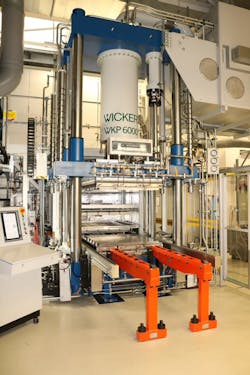Wickert compression press makes possible specialized aerospace applications
By Karen Hanna
Most laboratory presses are small, but for one German materials company, a mini machine simply wouldn’t cut it.
Neue Materialien Bayreuth (NMB) GmbH in Bayreuth has gone big, with a new 600-ton compression molding machine from Wickert, for use in R&D involving high-performance lightweight components, including fiber-reinforced plastics and foamed materials. Equipped with a variety of technologies to handle high temperatures up to 932 degrees Fahrenheit, the WKP 6000 S can achieve a platen temperature of 842 degrees Fahrenheit — hot enough to handle metals, as well as thermoplastics and thermosets.
“With one press, you can research on different materials and set different parameters to get different results. All the while having the most advanced system and capabilities possible,” said Matt Stachel, a sales representative for Wickert machines in North America.
NMB is using the press to study the fiber-reinforced plastics that are gaining popularity due to their potential in lightweighting applications for the aerospace industry.
According to NMB, the machine is used in a multi-step process that includes consolidation of different layers, the thermoforming of the layers and bead foaming. To accommodate the requirements of challenging materials such as PEEK, the machine is capable of fast heat and pressure build-up, with quick transfers between steps to ensure the material does not cool down inappropriately.
“Different materials have different specifications, but typically you only have a few seconds. This requires fast action on the transfer and fast closing of the press,” Stachel said.
According to Thomas Neumeyer, head of plastics for NMB, the company needed a press that could handle high temperatures, multiple functions and plastic-metal hybrids. The press boasts faster transfer handling and fast mold closing, he said.
“Forming metal sheets requires a high clamping force and high temperatures. In order to add fiber-reinforced high-performance plastics, these must not cool down and must be fed into the mold quickly. The press reaches closing speeds of up to 300mm per second,” Stachel said.
As part of NMB’s process, several layers enter the cold mold, the press closes and builds up pressure, generating heat; then, the mold cools down, releases the pressure, and the machine releases a consolidated plate. Next, the infrared pre-heating station heats up the consolidated plate, up to 806 degrees Fahrenheit for PEEK. Then, the plate returns to the press, which builds up pressure in Iess than 4 seconds in some cases. The machine heats up the press to a maximum temperature of 482 degrees Fahrenheit. The press then demolds a three-dimensional part. “The very quick transfer from leaving the IR heating heater to the press and buildup for the pressure is the most important feature,” Neumeyer said. “This is only possible with a very highly dynamic hydraulic control system and a very well programmed and optimized moving behavior.”
The press can create aesthetic surfaces in short cycles for thermoplastic composites and sandwich structures.
The press is equipped with an integrated plane-parallelism control system.
Similar presses could be specified with RocTool’s induction temperature control system or a PU injection system. Other options include active skewing technology, to make corrections to the straightness or angle of the mold in the system, and a variety of clamping configurations, such as magnetic clamping or locking bolts.
The new press’s unique characteristics are designed to handle NMB’s specific applications but embody Wickert’s commitment to building custom presses that address individual customers’ needs.
“This new press is difficult to compare with other laboratory presses,” Stachel said. “Our new technologies allow the heating platens to reach very high temperatures, as well as very fast closing movements. Added to this is the immense clamping force of 600 tons — all this combined in one press makes it so special.”
Karen Hanna, senior staff reporter
Contact:
Wickert Hydraulic Presses, Hebron, Ky., 859-372-3399, https://wickert-usa.com
Vital Statistics
| Clamping force | 600 tons |
| Closing time to maximum force | 4.2 seconds |
| Piston stroke | 4.9 feet |
| Maximum temperature of the pressurized water TCU | 392 degrees Fahrenheit |
| Maximum temperature of the oil TCU | 572 degrees Fahrenheit |
| Maximum temperature of the RocTool induction TCU | 932 degrees Fahrenheit |
About the Author
Karen Hanna
Senior Staff Reporter
Senior Staff Reporter Karen Hanna covers injection molding, molds and tooling, processors, workforce and other topics, and writes features including In Other Words and Problem Solved for Plastics Machinery & Manufacturing, Plastics Recycling and The Journal of Blow Molding. She has more than 15 years of experience in daily and magazine journalism.
